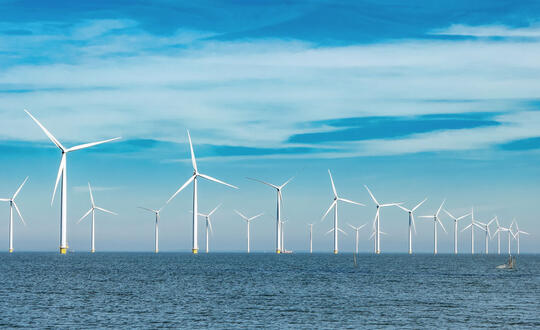
The south coast’s first offshore wind farm.
Completed in 2018 as part of R3, Rampion Offshore Wind Farm generates enough electricity to power the equivalent of almost 350,000 UK homes.
The site is located in the English Channel, off the Sussex coast and extends from approximately 13km to 20km offshore, occupying an irregular elongated area. The site has an overall area of 72km2, reduced from the original consented area of 122km2, which in turn was reduced from 167km2 following refinements to the scheme during the consultation and examination process. These refinements were designed to reduce the visual impact from the Heritage Coast, minimise deviation for vessels using the local route from the Traffic Separation Scheme to Shoreham Port and to reduce the impact on commercial fishing.
In 2008, nine strategic zones were identified for what is known as ‘Round 3’, the third licensing round for offshore wind farms. The nine strategic zones were established following a ‘Strategic Environmental Assessment’, which essentially investigated technological, engineering and environmental issues. Zone 6, the zone from within which the Rampion site was chosen, could not migrate further south owing to increased water depths and the Traffic Separation Scheme on the English Channel shipping lane.
Womble Bond Dickinson was instructed to:
- Obtain development consent, advising on the pre-application process, reviewing the draft application and presenting the application during the examination process both in written submissions and appearance at hearings
- Work with all 40 landowners to advise on transactional, real estate and property requirements including negotiation and agreement of the property documentation relating to the onshore cable route and substation and associated landfall arrangements
- Negotiate a tricky onshore connection that cuts across a national park
- To advise on offshore export cable failure and grant of revised rights from the Crown Estate.
Some of the biggest difficulties with the Rampion project came onshore: the land purchasing was especially convoluted, and Womble Bond Dickinson worked with 40 different landowners to acquire the ability to lay the cables required to connect to the grid.
From landfall at Brooklands Pleasure Park, almost 27 kilometres of buried onshore cable transports the power produced at Rampion to an onshore substation in Twineham, Mid Sussex.
The offshore array was visible from the South Downs National Park and the onshore cable crossed the National Park. A particularly sensitive section of the onshore cable at Tottington Mount in the South Downs National Park required specialist trenching and turfing machines to deal with the steep gradient and thin topsoil covering the chalk grassland.
How did WBD help to resolve the issues?
A section 106 Agreement addressed mitigation measures for the crossing of the National Park by the cable route and impacts from the offshore array. A readjustment of the red
line boundary for the offshore array was put forward to reduce the impact of the turbines on the Heritage Coast at Birling Gap and Beachy Head. A chalk grassland construction and management plan was put forward to ensure minimum impacts from burial of the onshore cable.
Key facts and figures
Construction cost
wind turbine generators
Annual Power generation
UK homes supplied (equivalent)
tonnes approximate emission reductions per annum
lease with The Crown Estate








